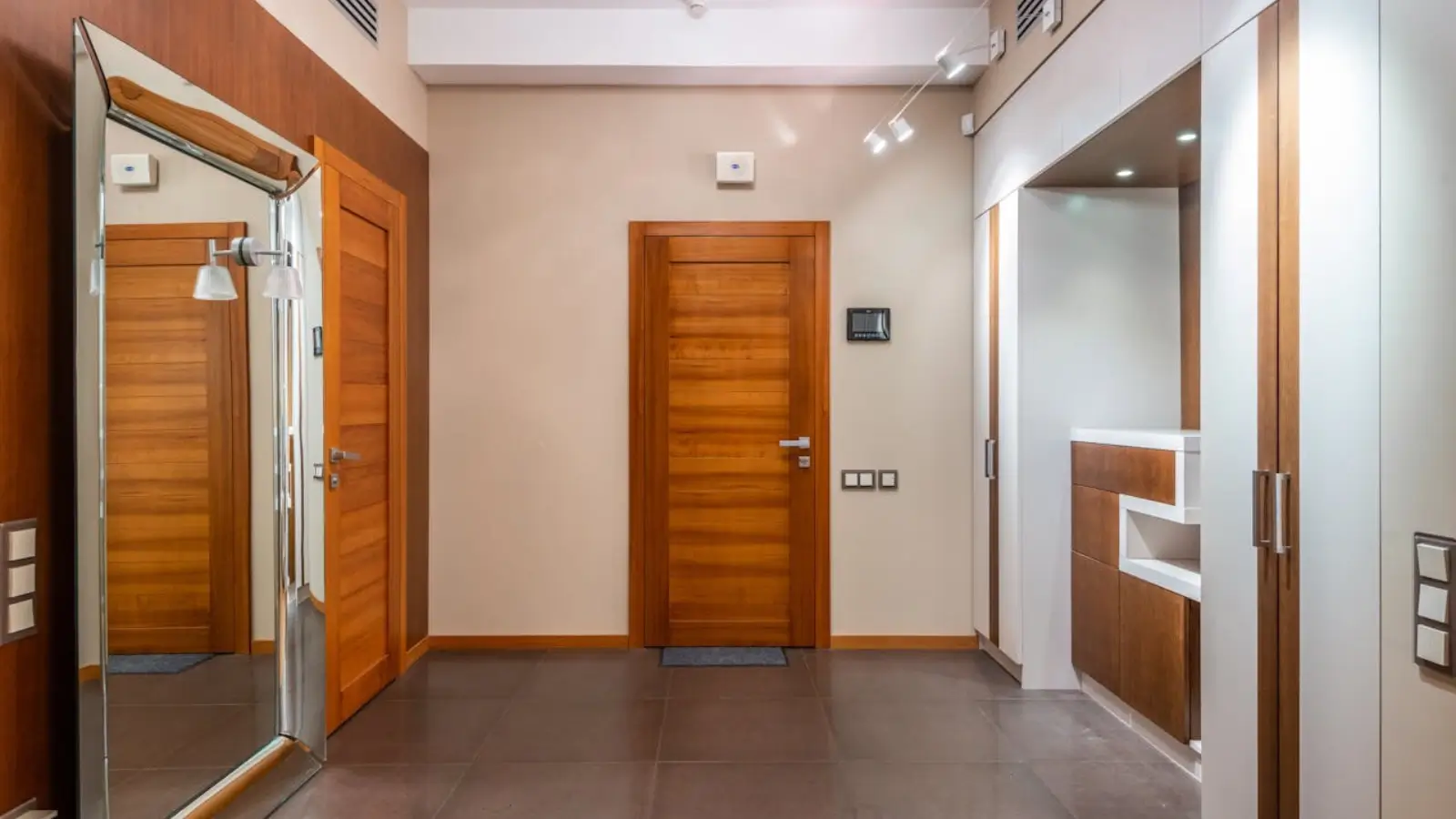— Fire doors like FD30 and FD60 are essential for slowing fire spread, protecting lives, and ensuring safe evacuation in today’s modern homes.
In 2025, home safety is a top priority, and fire doors play a pivotal role in meeting modern safety standards. Designed to resist fire and smoke, fire doors provide critical protection by slowing the spread of flames and creating safe escape routes. With ratings like FD30 and FD60, these doors are essential for safeguarding lives and property. This article explores the importance of fire doors, their role in complying with safety regulations, and how they enhance security in today’s homes.
What Are Fire Doors?
Fire doors are specially engineered to withstand fire and smoke for a specified period, typically rated as FD30 (30 minutes) or FD60 (60 minutes). Constructed with fire-resistant materials and equipped with intumescent seals, they act as barriers to contain flames and toxic smoke. These doors are a key component of a home’s fire safety strategy, ensuring occupants have time to evacuate or for emergency services to respond.
Why Fire Doors Are Crucial in 2025
Fires can escalate rapidly, with smoke posing a significant threat to safety. Fire doors are designed to:
- Contain Fire and Smoke: They limit the spread of flames and toxic gases, protecting unaffected areas of the home.
- Provide Escape Time: FD30 and FD60 ratings offer 30 or 60 minutes of resistance, allowing occupants to exit safely or await rescue.
- Reduce Property Damage: By containing fires, these doors minimize structural and material losses.
- Meet Safety Standards: Many regions now mandate fire doors in specific home areas to comply with modern building codes.
In 2025, as home safety awareness grows and regulations tighten, fire doors are a non-negotiable feature for responsible homeowners.
FD30 and FD60: Understanding the Ratings
- FD30 Fire Doors: These provide 30 minutes of fire and smoke resistance, making them suitable for most residential settings. Typically 44mm thick, they’re constructed with solid timber or composite cores and intumescent seals. They’re ideal for low- to medium-risk areas like hallways, kitchens, or bedroom entrances.
- FD60 Fire Doors: Offering 60 minutes of protection, FD60 doors are thicker (54mm or more) and use denser, fire-resistant cores. They’re designed for high-risk areas, such as multi-story homes, near flammable storage, or complex layouts requiring longer evacuation times.
Both types include fire-rated hardware and self-closing mechanisms to ensure functionality during a fire.
The Role of Fire Doors in Modern Safety Standards
Modern safety standards, driven by updated building codes in 2025, emphasize fire prevention and containment. Fire doors are integral to these regulations, often required in:
- Stairwells and Hallways: To maintain clear escape routes in multi-story homes.
- Kitchens and Utility Rooms: To isolate high-risk areas with appliances or flammable materials.
- Garages or Workshops: To prevent fires from spreading to living spaces.
- New Builds or Renovations: Many jurisdictions mandate FD30 or FD60 doors to meet compliance.
By installing certified fire doors, homeowners ensure adherence to these standards, potentially avoiding fines and enhancing insurability.
Benefits of Fire Doors for Home Security
Fire doors offer a range of advantages that go beyond compliance:
- Life-Saving Protection: They provide critical time for evacuation, reducing the risk of injury or fatality.
- Smoke Containment: Intumescent seals block toxic smoke, improving visibility and air quality during a fire.
- Property Preservation: Containing fires to specific areas minimizes damage and repair costs.
- Insurance Benefits: Many insurers offer lower premiums for homes with certified fire doors, recognizing their safety value.
- Aesthetic Integration: Modern fire doors come in stylish finishes, like wood veneer or painted designs, blending seamlessly with home decor.
Key Features to Look For
When selecting fire doors, prioritize these features to ensure performance and compliance:
- Certified Rating: Choose doors independently tested and certified to FD30 or FD60 standards.
- Intumescent Seals: These expand under heat to seal gaps, preventing smoke and flame leakage.
- Self-Closing Mechanisms: Automatic closers ensure the door shuts securely during a fire.
- Fire-Rated Hardware: Hinges, locks, and handles must withstand high temperatures without failing.
- Durable Materials: Solid timber, composite cores, or steel ensure longevity and fire resistance.
Choosing the Right Fire Door for Your Home
Selecting between FD30 and FD60 depends on your home’s needs:
- Risk Assessment: Use FD30 doors for standard areas like bedrooms or living rooms. Opt for FD60 doors in high-risk zones, such as near fuel storage or in multi-story homes.
- Building Regulations: Check local codes, as some areas require FD60 doors for specific locations like stairwells or attached garages.
- Escape Routes: FD60 doors are better for homes with longer or complex escape paths, providing extra time for evacuation.
- Aesthetics: Both ratings offer finishes like oak, walnut, or modern white to match your interior style.
- Budget: FD30 doors are more affordable, while FD60 doors are a higher investment for enhanced protection.
Installation and Maintenance Tips
Proper installation and care are critical for fire doors to function effectively:
- Professional Installation: Hire certified installers to ensure the door, frame, and hardware meet safety standards. Poor installation can void fire ratings.
- Regular Inspections: Check seals, hinges, and closers every 6–12 months for wear. Ensure gaps around the door are 2–4mm.
- Maintain Closers: Test self-closing mechanisms to confirm they shut the door fully, replacing faulty components promptly.
- Avoid Modifications: Do not drill, paint over seals, or alter the door, as this can compromise its integrity.
- Clean Carefully: Use a damp cloth and mild cleaner to maintain surfaces, avoiding damage to seals or finishes.
Fire Doors in 2025: Trends and Innovations
In 2025, Internal Fire Doors are evolving with cutting-edge features. Sleek designs with glass panels (using fire-rated glazing) or matte finishes blend safety with style. Smart fire doors with integrated sensors that detect heat or smoke and send alerts are gaining popularity. Sustainable materials, like FSC-certified timber or recycled composites, cater to eco-conscious homeowners, while advanced intumescent seals enhance performance.
Strategic Placement for Optimal Safety
Place fire doors strategically to maximize protection:
- Hallways and Staircases: Ensure clear, smoke-free escape routes.
- Kitchens: Contain cooking-related fire risks.
- Garages or Utility Areas: Isolate flammable materials or appliances.
- Multi-Story Homes: Use FD60 doors to protect vertical escape paths.
Combine fire doors with smoke alarms, fire extinguishers, and escape plans for a comprehensive safety strategy.
Why Fire Doors Are a Smart Investment
Fire doors enhance home security by protecting lives, reducing property damage, and ensuring compliance with modern standards. They may lower insurance costs and increase home value by demonstrating a commitment to safety. With durable construction and minimal maintenance, they offer long-term reliability, making them a cost-effective addition to any home.
Conclusion
FD30 and FD60 fire doors are essential for meeting modern safety standards and securing your home in 2025. By slowing the spread of fire and smoke, they provide critical time for evacuation and protect your property. With stylish designs, innovative features, and proper installation, fire doors blend seamlessly into your home while delivering life-saving benefits. Invest in the right fire door today to enhance safety, comply with regulations, and gain peace of mind in an unpredictable world.


